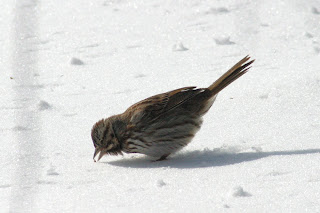As the snow and ice melts and the waterfowl returns to the open waters, birders bust out of their houses ill with cabin fever. Waking up early even on the weekend, we visit the beautiful marshes of Blackwater National Wildlife Refuge to view migrating geese, ducks, swans, sparrows, and eagles. Bald eagles adorn the periphery of our views as we focus on a rough-legged hawk and watch a peregrine falcon dive into the tall confident loblollies. Yellow-rumped warblers buzz over our heads as we pish for tree sparrows. Horned larks and American pipits ignore our car engines and squeaking windows as we pause to admire their foraging party.

Horned Lark
"Great flocks come down the Atlantic coast in October and November, and separate into smaller bands that take up their residence in sandy stretches and open tracts near the sea or wherever the food supply looks promising, and there the larks stay until all the seeds, buds of bushes, berries, larvae, and insects in their chosen territory are exhausted. They are ever conspicuously ground birds, walkers, and when disturbed at their dinner, prefer to squat on the earth rather than expose themselves by flight. Sometimes they run nimbly over the frozen ground to escape an intruder, but flying they reserve as a last resort. When the visitor has passed they quickly return to their dinner. If they were content to eat less ravenously and remain slender, fewer victims might be slaughtered annually to tickle the palates of the epicure. It is a mystery what they find to fatten upon when snow covers the frozen ground. Even in the severe midwinter storms they will not seek the protection of the woods, but always prefer sandy dunes with their scrubby undergrowth or open meadow lands." - Bird Neighbors by Neltje Blanchan, 1904

Yellow-rumped Warbler in the Phragmites looking for attention. (and gladly given)

Tree Sparrow
"The tree sparrow actually does not show half the preference for trees that its familiar little counterpart [chipping sparrow] does, but rather keeps to low bushes when not on the ground, where we usually find it... Sheltered from the high, wintry winds in the furrows and dry ditches of ploughed fields, a loose flock of these actice birds keep up a merry hunt for fallen seeds and berries, with a belated beetle to give the grain a relish." -Bird Neighbors by Neltje Blanchan, 1904

Snow Geese
I could tape eight of these pictures together end to end and still wouldn't capture the entire flock. Birders estimated the flock at over 11,000 birds. Beautiful! And amazing that Earth is bountiful enough to sustain them all at once!

Tundra Swans
































